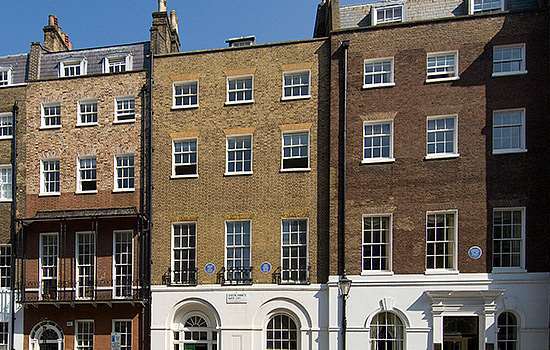The Earliest Plaques
The earliest plaques, commissioned by the Society of Arts, were handmade by the pottery firm Minton, Hollins & Co. The inlaid or encaustic roundel had a distinctive border pattern with the letters of the name of the Society of Arts worked into the decorative design. Some were set into a painted wooden mount.
The very earliest plaques were blue, but this was an expensive and difficult colour to produce and over the next 35 years the Society mainly used a chocolate brown background.
New Designs and Colours
After taking over the scheme in 1901, the London County Council (LCC) continued to use the Minton factory, and they developed a highly decorative laurel wreath border with ribbon embellishments. Although they regularly experimented with the design and the colour, the wreathed border was consistently used up until the Second World War.
Following a detailed report from the LCC's chief architect, blue ceramic plaques became standard from 1921 – they were felt to stand out best in the London streetscape. They were made by Doulton from 1923 to 1955. Between 1925 and 1926, Doulton made seven (of which five survive) with a colourful raised wreath border, known as a della Robbia style.
During the LCC era, plaques were sometimes made of bronze, stone and lead, some were square or rectangular, and they varied in colour between brown, sage, terracotta and blue.
In 1938, the modern design of the blue plaque was born, created by an unnamed student of the Central School of Arts and Crafts who was paid just four guineas for his or her trouble. This omitted the laurel wreath and ribbon border, and simplified the overall layout, allowing for a bolder spacing and arrangement of the lettering.
The Last 50 Years
Since 1965, the GLC and English Heritage have continued – with only a few, very occasional exceptions – to use the standard blue roundel. Today, the name English Heritage is always inscribed on the top edge and our logo of a crenallated square is centered on the bottom edge. Our current specifications state that plaques should be 495mm (19½ inches) in diameter and 50mm (2 inches) thick.
Subtle changes in the font and layout of the text have developed over the years, but the general formatting principles have remained the same for some time. These dictate that the name appears in capitals with the surname slightly larger, followed by life dates, profession or accomplishment, and then the commemorated figure’s relationship to the building – whether they were born, lived, worked or died there, or any combination of the above.
The Plaque Makers
English Heritage plaques are made by highly skilled artisan craftspeople, Frank and Sue Ashworth of London Plaques, who have been creating them since 1984. The surface is slightly domed to encourage self-cleaning, and the lettering, because it is handpiped, is slightly raised. As long as the plaques are protected during any building works, they will last for as long as the building they are attached to.
More About Blue Plaques
-

History of Blue Plaques
Discover more about the 150-year-old history of the blue plaque scheme.
-

Top 10 Blue Plaque Facts
Blue plaques provide an intriguing glimpse into London’s past. Discover some fascinating and little-known facts about them.
-

Find a Blue Plaque
Discover who has been commemorated by one of the blue plaques on buildings across London.
